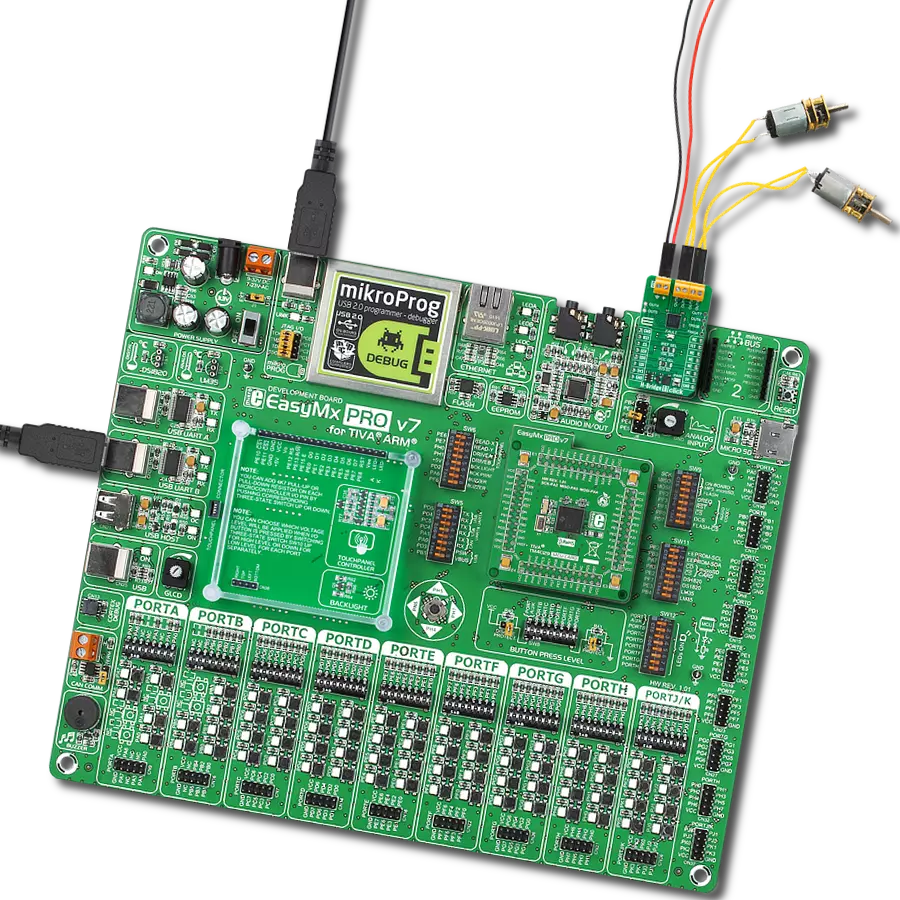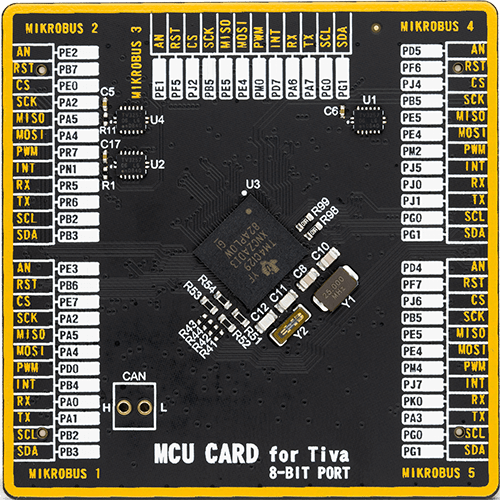Streamline the operation of multiple solenoids and motors, and ensure synchronized movements and optimized performance in various systems
A
A
Hardware Overview
How does it work?
H-Bridge 11 Click is based on the MAX22200, an octal serial-controlled solenoid and motor driver from Analog Devices. The MAX22200 is rated for an operating voltage range from 4.5V to 36V, which can be brought externally through a VIN screw terminal. Each channel, market with OUTx, can be configured as a low-side or high-side driver and features a low-impedance with 200mΩ typical ON-resistance push-pull output stage with sink-and-source driving capability and up to 1A RMS driving current. Also, pairs of half-bridges can be paralleled to double the driving current or can be configured as full-bridges to drive up to four latched valves (bistable valves) or four brushed DC motors. The MAX22200 features a two-level drive sequence for optimal control of solenoid valves such as voltage-drive (VDR) and current-drive regulation (CDR) (low-side driver only). In VDR mode, the MAX22200 outputs a PWM voltage with a programmable duty cycle through the SPI interface. The output current is proportional to the programmed duty cycle for a given supply voltage and solenoid resistor. In CDR mode, an internal
integrated lossless current sensing (ICS) circuit senses the output current and compares it with a programmable reference current. The CDR loop modifies the PWM duty cycle so that the output current peak matches the programmed reference current. Reference current can be set using the IREF SEL jumper, providing the possibility of setting a current of 1A, 0.5A, or 0.25A depending on the position of the jumper and the set HFS bit (jumper at position 15k with HFS_bit=0 provides 1A, jumper at position 30k with HFS_bit=1 provides 0.25A). This Click board™ communicates with MCU through a standard SPI interface, supporting clock speed up to 5MHz and the most common SPI mode, SPI Mode 0. It also can be turned on or off through the RST pin of the mikroBUS™ socket, hence, offering a switch operation to turn ON/OFF power delivery to the MAX22200. Depending on the content of the TRGnSPI bit in the configuration register of that specific channel, the driver channels can be activated/deactivated either using the SPI interface or through a logic input signal on unpopulated header pins TRIGA
and TRIGB (0, 2, 4, 6 can be triggered by the logic input TRIGA, while 1, 3, 5, 7 can be triggered by using the logic input TRIGB). For a successful register write/read function, it is first necessary to set the CMD pin of the mikroBUS™ socket to an appropriate logic level: high for the write and low for the read command. It also provides a fault status indication signal, routed to the FLT pin of the mikroBUS™ socket, alongside its red LED indicator marked as FAULT to indicate different fault conditions such as overcurrent protection, thermal shutdown, undervoltage lockout, open-load detection, and detection of plunger movement. This Click board™ can operate with either 3.3V or 5V logic voltage levels selected via the VCC SEL jumper. This way, both 3.3V and 5V capable MCUs can use the communication lines properly. The Click board™ comes equipped with a library containing easy-to-use functions and an example code that can be used, as a reference, for further development.
Features overview
Development board
EasyMx PRO v7 for TIVA is the seventh generation of ARM development boards specially designed for the needs of rapid development of embedded applications. It supports a wide range of 32-bit ARM microcontrollers from Texas Instruments and a broad set of unique functions, such as a powerful onboard mikroProg programmer and In-Circuit debugger over USB-B. The development board is well organized and designed so that the end-user has all the necessary elements, such as switches, buttons, indicators, connectors, and others, in one place. With two different connectors for each port, EasyMx PRO v7 for TIVA allows you to connect accessory boards, sensors, and custom electronics more efficiently than ever. Each part of the EasyMx
PRO v7 for TIVA development board contains the components necessary for the most efficient operation of the same board. An integrated mikroProg, a fast USB 2.0 programmer with mikroICD hardware In-Circuit Debugger, offers many valuable programming/debugging options and seamless integration with the Mikroe software environment. Besides it also includes a clean and regulated power supply block for the development board. It can use a wide range of external power sources, including an external 12V power supply, 7-23V AC or 9-32V DC via DC connector/screw terminals, and a power source via the USB Type-B (USB-B) connector. Communication options such as USB-UART, USB-HOST/DEVICE, CAN, and
Ethernet are also included, including the well-established mikroBUS™ standard, one display option for the TFT board line of products, and a standard TQFP socket for the seventh-generation MCU cards. This socket covers a wide range of 32-bit TIVA-series ARM Cortex-M4 MCUs. EasyMx PRO v7 for TIVA is an integral part of the Mikroe ecosystem for rapid development. Natively supported by Mikroe software tools, it covers many aspects of prototyping and development thanks to a considerable number of different Click boards™ (over a thousand boards), the number of which is growing every day.
Microcontroller Overview
MCU Card / MCU

Type
7th Generation
Architecture
ARM Cortex-M4
MCU Memory (KB)
1024
Silicon Vendor
Texas Instruments
Pin count
212
RAM (Bytes)
262144
You complete me!
Accessories
DC Gear Motor - 430RPM (3-6V) represents an all-in-one combination of a motor and gearbox, where the addition of gear leads to a reduction of motor speed while increasing the torque output. This gear motor has a spur gearbox, making it a highly reliable solution for applications with lower torque and speed requirements. The most critical parameters for gear motors are speed, torque, and efficiency, which are, in this case, 520RPM with no load and 430RPM at maximum efficiency, alongside a current of 60mA and a torque of 50g.cm. Rated for a 3-6V operational voltage range and clockwise/counterclockwise rotation direction, this motor represents an excellent solution for many functions initially performed by brushed DC motors in robotics, medical equipment, electric door locks, and much more.
Used MCU Pins
mikroBUS™ mapper
Take a closer look
Click board™ Schematic

Step by step
Project assembly
Track your results in real time
Application Output
1. Application Output - In Debug mode, the 'Application Output' window enables real-time data monitoring, offering direct insight into execution results. Ensure proper data display by configuring the environment correctly using the provided tutorial.

2. UART Terminal - Use the UART Terminal to monitor data transmission via a USB to UART converter, allowing direct communication between the Click board™ and your development system. Configure the baud rate and other serial settings according to your project's requirements to ensure proper functionality. For step-by-step setup instructions, refer to the provided tutorial.

3. Plot Output - The Plot feature offers a powerful way to visualize real-time sensor data, enabling trend analysis, debugging, and comparison of multiple data points. To set it up correctly, follow the provided tutorial, which includes a step-by-step example of using the Plot feature to display Click board™ readings. To use the Plot feature in your code, use the function: plot(*insert_graph_name*, variable_name);. This is a general format, and it is up to the user to replace 'insert_graph_name' with the actual graph name and 'variable_name' with the parameter to be displayed.

Software Support
Library Description
This library contains API for H-Bridge 11 Click driver.
Key functions:
hbridge11_get_fault_pin- This function returns the fault pin logic statehbridge11_read_flags- This function reads and clears the fault flags from the status registerhbridge11_set_motor_state- This function sets the operating state for the selected motor from the half-bridge pairs 0-1, 2-3, 4-5, or 6-7
Open Source
Code example
The complete application code and a ready-to-use project are available through the NECTO Studio Package Manager for direct installation in the NECTO Studio. The application code can also be found on the MIKROE GitHub account.
/*!
* @file main.c
* @brief H-Bridge 11 Click example
*
* # Description
* This example demonstrates the use of the H-Bridge 11 Click board by
* driving the DC motors connected between OUT0-OUT1 and OUT2-OUT3 in both directions.
*
* The demo application is composed of two sections :
*
* ## Application Init
* Initializes the driver and performs the Click default configuration.
*
* ## Application Task
* Drives the motors connected between OUT0-OUT1 and OUT2-OUT3 in both directions
* in the span of 12 seconds, and logs data on the USB UART where you can track the program flow.
*
* @author Stefan Filipovic
*
*/
#include "board.h"
#include "log.h"
#include "hbridge11.h"
static hbridge11_t hbridge11;
static log_t logger;
/**
* @brief H-Bridge 11 check fault function.
* @details This function checks the fault pin state then reads the fault flags
* and displays on the USB UART.
* @return None.
* @note None.
*/
static void hbridge11_check_fault ( void );
void application_init ( void )
{
log_cfg_t log_cfg; /**< Logger config object. */
hbridge11_cfg_t hbridge11_cfg; /**< Click config object. */
/**
* Logger initialization.
* Default baud rate: 115200
* Default log level: LOG_LEVEL_DEBUG
* @note If USB_UART_RX and USB_UART_TX
* are defined as HAL_PIN_NC, you will
* need to define them manually for log to work.
* See @b LOG_MAP_USB_UART macro definition for detailed explanation.
*/
LOG_MAP_USB_UART( log_cfg );
log_init( &logger, &log_cfg );
log_info( &logger, " Application Init " );
// Click initialization.
hbridge11_cfg_setup( &hbridge11_cfg );
HBRIDGE11_MAP_MIKROBUS( hbridge11_cfg, MIKROBUS_1 );
if ( SPI_MASTER_ERROR == hbridge11_init( &hbridge11, &hbridge11_cfg ) )
{
log_error( &logger, " Communication init." );
for ( ; ; );
}
if ( HBRIDGE11_ERROR == hbridge11_default_cfg ( &hbridge11 ) )
{
log_error( &logger, " Default configuration." );
for ( ; ; );
}
log_info( &logger, " Application Task " );
}
void application_task ( void )
{
hbridge11_set_motor_state ( &hbridge11, HBRIDGE11_MOTOR_SEL_0, HBRIDGE11_MOTOR_STATE_FORWARD );
hbridge11_set_motor_state ( &hbridge11, HBRIDGE11_MOTOR_SEL_1, HBRIDGE11_MOTOR_STATE_FORWARD );
log_printf( &logger, "\r\n MOTOR 0: FORWARD\r\n" );
log_printf( &logger, " MOTOR 1: FORWARD\r\n" );
hbridge11_check_fault ( );
Delay_ms ( 1000 );
Delay_ms ( 1000 );
Delay_ms ( 1000 );
hbridge11_set_motor_state ( &hbridge11, HBRIDGE11_MOTOR_SEL_0, HBRIDGE11_MOTOR_STATE_BRAKE );
hbridge11_set_motor_state ( &hbridge11, HBRIDGE11_MOTOR_SEL_1, HBRIDGE11_MOTOR_STATE_BRAKE );
log_printf( &logger, "\r\n MOTOR 0: BRAKE\r\n" );
log_printf( &logger, " MOTOR 1: BRAKE\r\n" );
hbridge11_check_fault ( );
Delay_ms ( 1000 );
Delay_ms ( 1000 );
Delay_ms ( 1000 );
hbridge11_set_motor_state ( &hbridge11, HBRIDGE11_MOTOR_SEL_0, HBRIDGE11_MOTOR_STATE_REVERSE );
hbridge11_set_motor_state ( &hbridge11, HBRIDGE11_MOTOR_SEL_1, HBRIDGE11_MOTOR_STATE_REVERSE );
log_printf( &logger, "\r\n MOTOR 0: REVERSE\r\n" );
log_printf( &logger, " MOTOR 1: REVERSE\r\n" );
hbridge11_check_fault ( );
Delay_ms ( 1000 );
Delay_ms ( 1000 );
Delay_ms ( 1000 );
hbridge11_set_motor_state ( &hbridge11, HBRIDGE11_MOTOR_SEL_0, HBRIDGE11_MOTOR_STATE_HI_Z );
hbridge11_set_motor_state ( &hbridge11, HBRIDGE11_MOTOR_SEL_1, HBRIDGE11_MOTOR_STATE_HI_Z );
log_printf( &logger, "\r\n MOTOR 0: DISCONNECTED\r\n" );
log_printf( &logger, " MOTOR 1: DISCONNECTED\r\n" );
hbridge11_check_fault ( );
Delay_ms ( 1000 );
Delay_ms ( 1000 );
Delay_ms ( 1000 );
}
int main ( void )
{
/* Do not remove this line or clock might not be set correctly. */
#ifdef PREINIT_SUPPORTED
preinit();
#endif
application_init( );
for ( ; ; )
{
application_task( );
}
return 0;
}
static void hbridge11_check_fault ( void )
{
uint8_t fault_flags = 0;
if ( !hbridge11_get_fault_pin ( &hbridge11 ) )
{
if ( HBRIDGE11_OK == hbridge11_read_flags ( &hbridge11, &fault_flags ) )
{
log_printf ( &logger, " Fault flags: 0x%.2X\r\n", ( uint16_t ) fault_flags );
}
}
}
// ------------------------------------------------------------------------ END



































